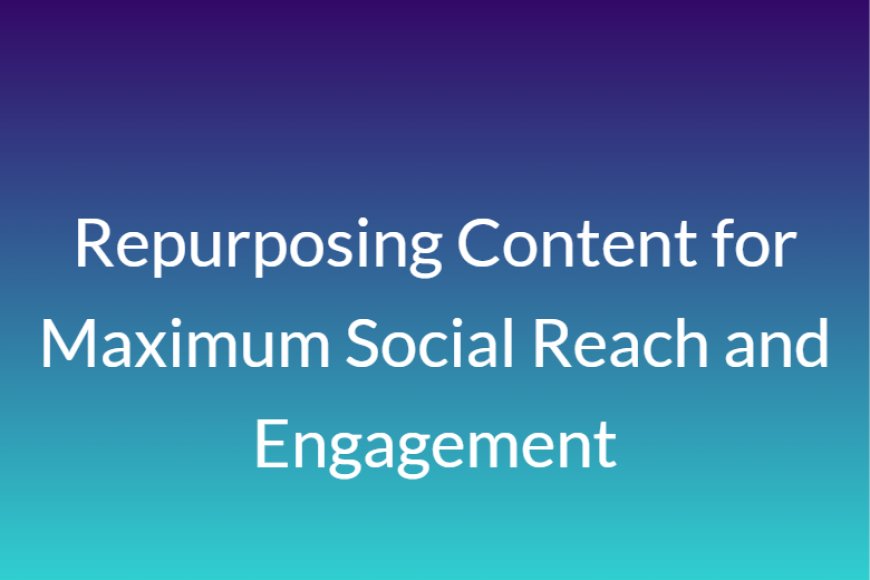Repurposing Content for Maximum Social Reach and Engagement
One of the smartest and most sustainable strategies in B2B Social Media Marketing is content repurposing. With the sheer volume of content required to stay relevant, attract leads, and engage audiences, B2B marketers must learn to stretch their assets without sacrificing quality.

Repurposing enables you to take existing content like blogs, webinars, whitepapers, or videos and turn them into fresh, platform-specific assets for social distribution. The result? More consistent posting, greater reach, and stronger engagement all while saving time and resources.
In this blog, well explore how repurposing fuels scalable B2B Social Media Marketing strategies, the best formats for each platform, and actionable ways to transform your high-performing content into new audience touchpoints.
Why Repurposing Matters in B2B Social Media Marketing
B2B buyers require multiple interactions before engaging with sales, often consuming different types of content across various channels. Repurposing supports this journey by:
-
Reinforcing your core message in multiple formats
-
Reaching new audience segments
-
Catering to different learning preferences (readers, listeners, viewers)
-
Maximizing ROI from long-form content creation
-
Reducing time and effort in content production
Effective B2B Social Media Marketing doesnt always require new contentit requires strategically repackaged content delivered at the right time and place.
Core Content Types to Repurpose
Before diving into repurposing methods, its important to start with the right core assets. The best content to repurpose includes:
-
Blogs
-
Whitepapers or eBooks
-
Webinars
-
Case Studies
-
Research Reports
-
Podcasts or Video Interviews
Each of these can be broken down and adapted for your B2B Social Media Marketing channels, with different angles, formats, and objectives.
Ways to Repurpose Long-Form Blogs for Social Media
1. Pull Quote Graphics
Take powerful insights or data points from your blog and turn them into branded quote cards. These are perfect for platforms like LinkedIn, X (Twitter), and Instagram.
Example:
78% of B2B buyers consume at least 3 pieces of content before speaking with sales.
2. Short Text Posts
Summarize the blogs key points into a short-form post for LinkedIn. This can be presented as:
-
A listicle
-
A mini-thread
-
A how-to summary
-
A bold opinion post
3. Carousel Posts
Transform blog sections into a visual carousel post (PDF or image slides) that users can swipe through. Ideal for LinkedIn and Instagram.
Topics to Use:
-
Frameworks
-
Step-by-step guides
-
Mistake lists
-
Statistics and analysis
4. Video Snippets
Use your blog as a script or source for a short video where a team member explains a key insight in 6090 seconds.
Video content enhances your B2B Social Media Marketing by increasing reach and engagement, especially on LinkedIn and YouTube.
Repurposing Webinars into Social Assets
Webinars are content goldmines that can be sliced and diced into dozens of social assets. Heres how:
1. Video Clips
Break the recording into 3060 second highlight reels. Focus on:
-
Guest speaker soundbites
-
Key statistics
-
Audience Q&A
These short clips can be posted natively to LinkedIn or YouTube Shorts.
2. Blog Summaries
Turn the webinar content into a comprehensive blog post or multiple shorter posts. Each section can become a standalone insight.
3. Quote Cards & Visual Highlights
Pull memorable quotes or tips and turn them into branded visuals for sharing.
4. Slide Deck Carousels
Convert presentation slides into PDF carousels for social. These offer great visibility and save time for users who missed the live session.
Repurposing webinars extends their value beyond the live date, reinforcing key themes within your B2B Social Media Marketing funnel.
Repurposing Whitepapers & Reports
Whitepapers and reports are high-effort assets. Repurposing them ensures you generate maximum ROI and exposure.
1. Teaser Posts
Extract the biggest insights into a teaser graphic and encourage users to download the full report via a CTA.
Example Post:
Only 12% of B2B marketers say they fully understand intent data. Our latest report reveals why.
2. Data Visualizations
Create infographics, pie charts, or bar graphs to present your findings visually.
3. Thought Leadership Articles
Break the report into sections and develop executive-level opinion posts around the insights.
These strategies help drive traffic and engagement in your B2B Social Media Marketing while positioning your brand as a credible industry source.
Optimizing Content for Each Platform
Different social platforms favor different types of repurposed content. To get the most from your efforts, tailor formats accordingly:
-
Text-based posts
-
Carousels
-
Native video clips
-
Long-form articles
-
Thought leadership quotes
X (Twitter)
-
Quick stats or takeaways
-
Threads with embedded blog links
-
Short video clips
-
Event promotion snippets
-
Short videos
-
Infographics
-
Event recaps
-
eBook promotion
-
Branded quote graphics
-
Short-form video Reels
-
Carousel visuals
-
Behind-the-scenes photos
YouTube
-
Webcast replays
-
Interview clips
-
Animated explainers
-
Industry trends breakdown
Adapting content by platform improves your visibility and aligns with how your audience consumes content within your B2B Social Media Marketing plan.
Creating a Repurposing Workflow
A strategic workflow ensures consistent, scalable repurposing across campaigns:
Step 1: Identify Core Content Assets
Choose a primary assetwebinar, blog, whitepaperthat aligns with your current campaign.
Step 2: Audit for Repurposable Segments
Highlight key takeaways, quotes, data, or visuals that can be spun into standalone assets.
Step 3: Assign Content Types per Platform
Decide what type of asset will work best per platform (e.g., a video on LinkedIn, a stat graphic on Instagram).
Step 4: Design & Schedule Posts
Create assets in batches and schedule them across multiple days or weeks for maximum reach.
Step 5: Measure Performance & Optimize
Track engagement, click-throughs, and lead conversions from each asset. Focus future repurposing on the formats that perform best.
A consistent repurposing workflow supports long-term success in B2B Social Media Marketing and keeps your brand active without burnout.
Encouraging Employee Sharing of Repurposed Content
One of the biggest benefits of repurposing is ease of distribution. Give your team pre-approved assets they can quickly share.
Tips:
-
Create a monthly social sharing kit
-
Include ready-made captions and visuals
-
Provide variations for different roles (sales, product, HR)
-
Recognize employees who drive engagement
When your team shares repurposed content, your B2B Social Media Marketing gains credibility, reach, and authenticity.
Read the Full Blog Now @ https://acceligize.com/featured-blogs/a-complete-guide-to-b2b-social-media-marketing-that-works/
About Us
Acceligize is a global B2B demand generation leader that specializes in helping businesses generate qualified leads, enhance brand awareness, and accelerate sales growth. With a focus on data-driven marketing and strategic execution, Acceligize empowers enterprises to optimize their sales funnels and maximize ROI across digital platforms. Our expertise spans content syndication, account-based marketing, and full-funnel demand generation campaigns tailored for the modern B2B buyer journey.
























